German Schnitzel (Schweineschnitzel)
This post may contain affiliate links. See my disclosure policy.
This traditional German Schnitzel recipe, known as Schweineschnitzel, is just the way you know and love it from your favorite German restaurants! Made the way I learned it from my Mutti and Oma, this tutorial includes all the tips and tricks are included for making the absolute PERFECT Schnitzel!
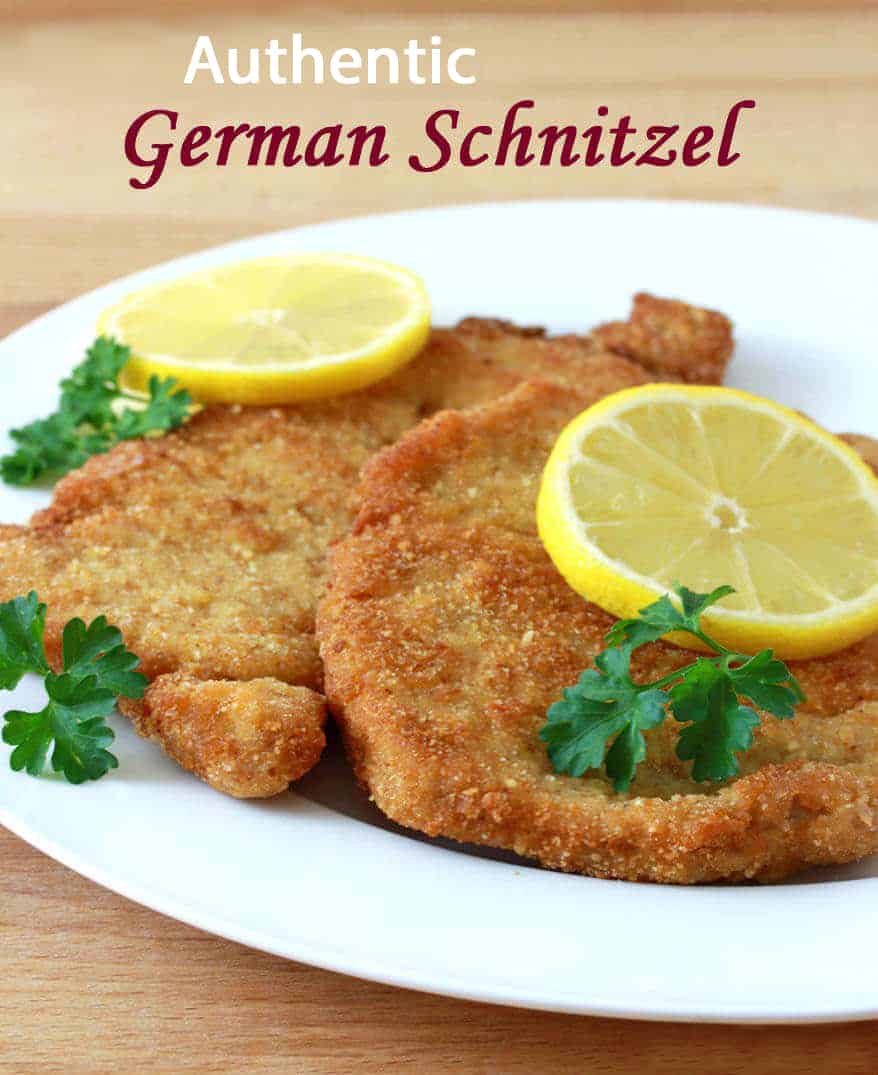
Being from Germany and as much as I love to cook, it would be unforgivably inexcusable, a total outrage, if I didn’t know how to make Schnitzel! After all, it’s one of the most quintessential German dishes. Practically every tourist to Germany has had Schnitzel and most fall in love with it.
Schnitzel vs. Wienerschnitzel: What’s the Difference?
Many people associate Schnitzel with Wienerschnitzel. However, “Wienerschnitzel” is actually a geographically protected term in Germany and Austria and can only be made with veal. German Schnitzel is prepared the same way as Austrian Wienerschnitzel, but the difference is that German Schnitzel, known as Schweineschnitzel, is made with pork instead of veal. As for where the Schnitzel originally came from…the technique of breading and frying thin cuts of meat is attributed to the Romans from around 1 BC. Another factual tidbit: Austrians will be the first to admit that Wienerschnitzel doesn’t come from Wien (Vienna).
But whether it’s Schweineschnitzel or Wienerschnitzel, when it’s perfectly breaded, perfectly fried, and perfectly crispy, practically everyone loves a good Schnitzel! And now you can make it – perfectly – in your own kitchen!
Variations
The most popular variations of Schnitzel are Jägerschnitzel (“hunter schnitzel”) which is served with mushroom gravy, Zigeunerschnitzel (“gypsy schnitzel”), served with a zesty bell pepper sauce, and Rahmschnitzel (“cream schnitzel”) served with a delicious creamy Rahm Sauce. All three are commonly found in German restaurants and are all positively delicious. If you love Schnitzel you have to try them all!
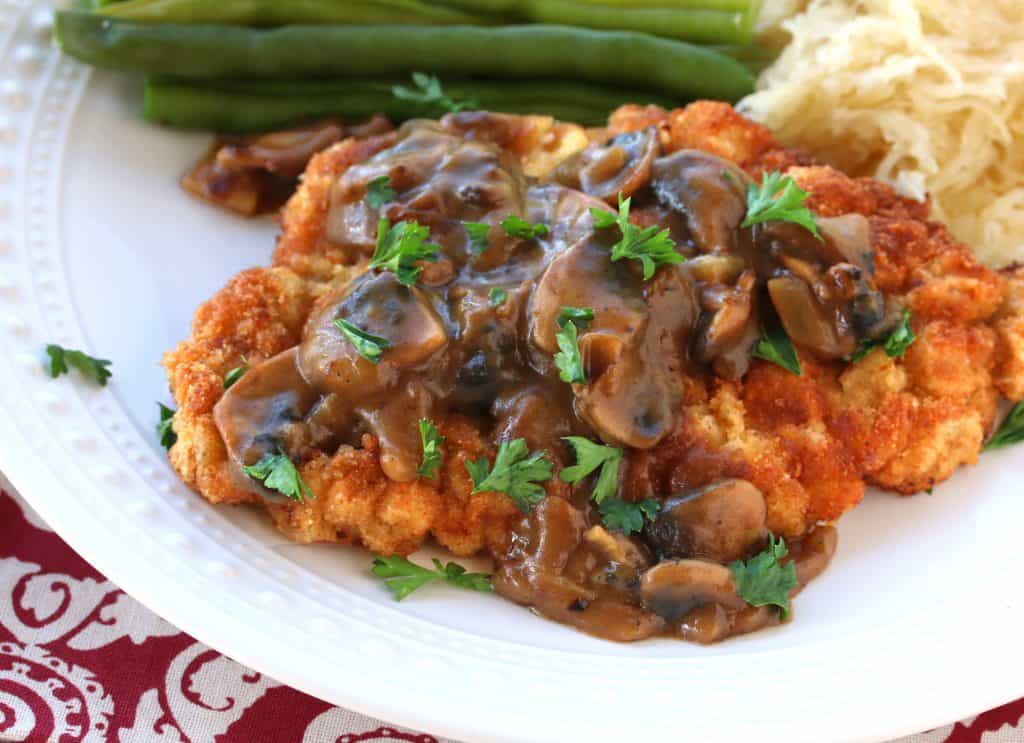
Schnitzel Recipe
Let’s get started!
Throughout the pictured recipe steps below, I’m going to share some tips and tricks with you that are important for achieving perfect results – just like the kind you get at a German restaurant.
Pro Tip 1: Pound the meat very thin, no more than 1/4 inch thick. The reason this is important is because you’ll need to fry it at high heat for a short period of time to get that perfect crispy crust without leaving the middle of the meat raw.
The easiest way to pound the pork is to lay it between two pieces of plastic wrap. Be sure to pound them using the flat side of a meat mallet. Lightly sprinkle each side with salt and pepper. Dip the pork into the flour, coating all sides.
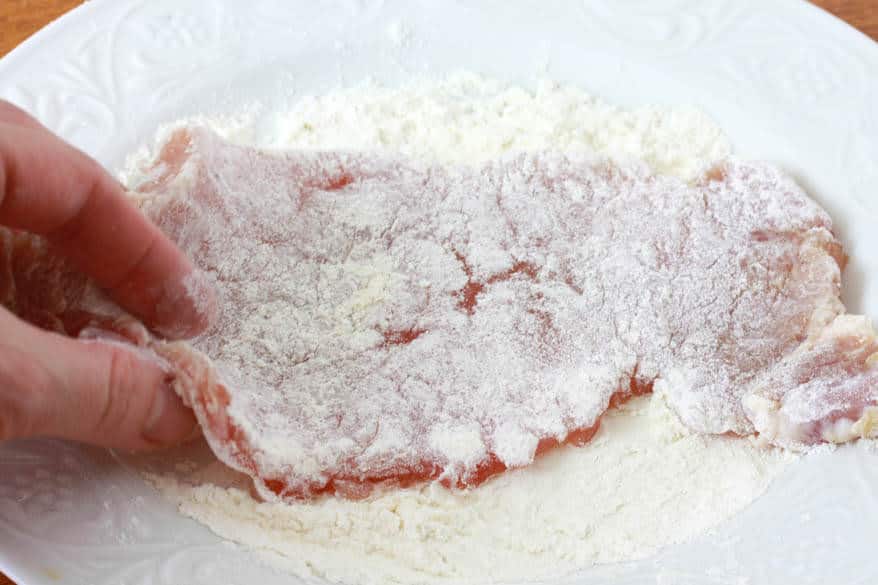
Next dip the pork into the egg mixture, coating all sides.
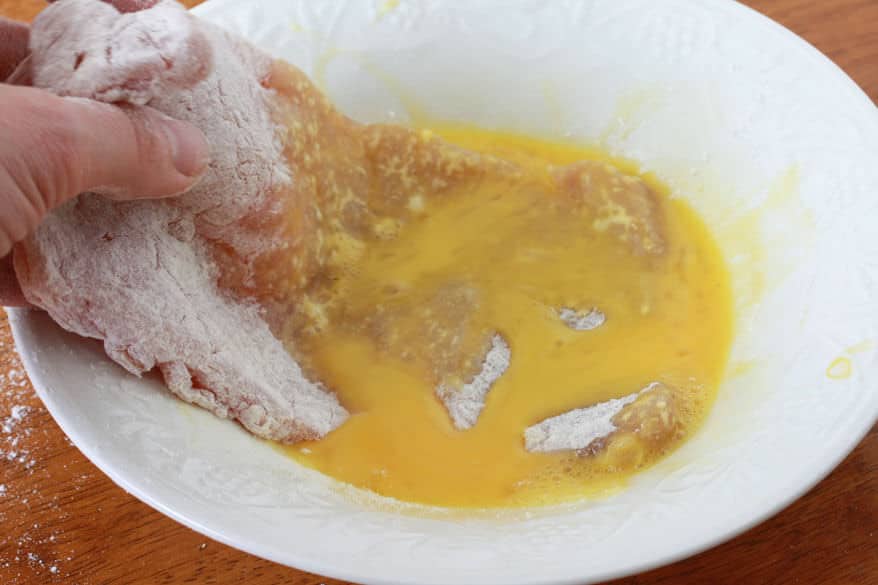
Then coat the pork with the breadcrumbs.
Pro Tip 2: Don’t press the breadcrumbs into the meat. Just softly coat the pork on both sides and all edges, and then gently shake off any excess.
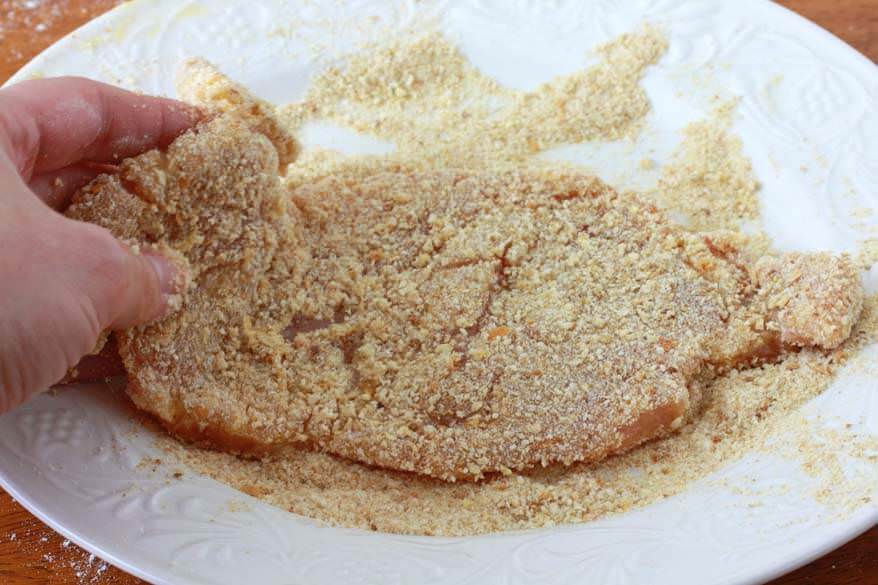
Pro Tip 3: Fry the Schnitzel immediately. Don’t let them sit in coating or the end result won’t be as crispy. You don’t need a ton of oil, but you need enough so that the Schnitzel can “swim”.
Pro Tip 4: Make sure the oil is hot enough – but not too hot. It should be around 330ºF – test it with a candy thermometer. If it’s too hot, the crust will burn before the meat is done. If it isn’t hot enough, you’ll end up with a soggy coating. When the oil is hot enough it will actually penetrate the coating less and you’ll end up with a crispy “dry” coating instead of an overly oily one. The result will be a beautifully crispy coating with a tender and juicy interior, and that’s exactly what we want.
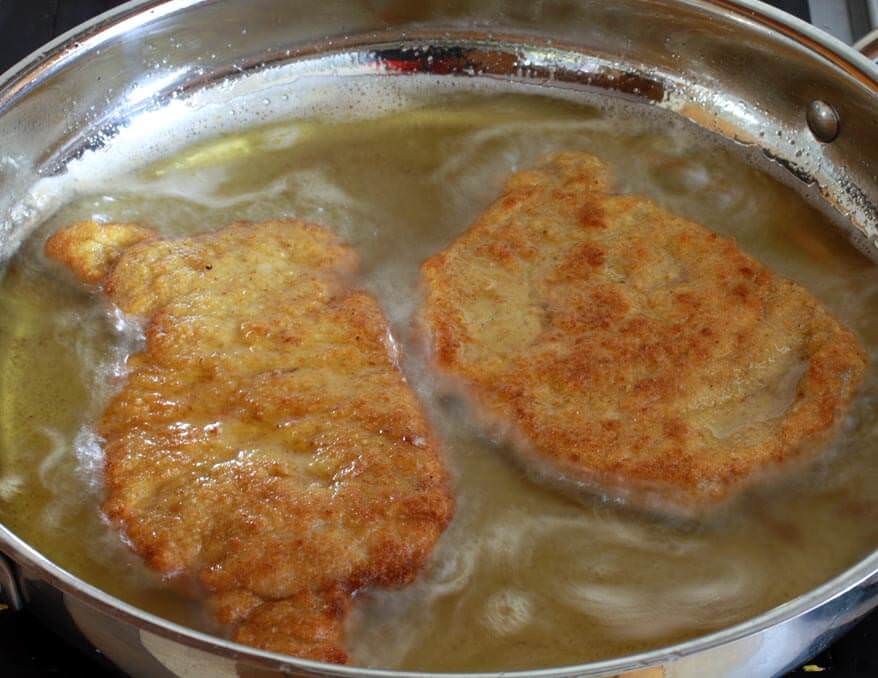
Remove the Schnitzel from the fry pan and place them briefly on a plate lined with paper towels. Transfer them to serving plates and garnish with slices of lemon and fresh parsley sprigs.
Serve immediately with French fries, Spätzle, or German potato salad and a fresh leafy green salad. See blog post below for more serving recommendations.
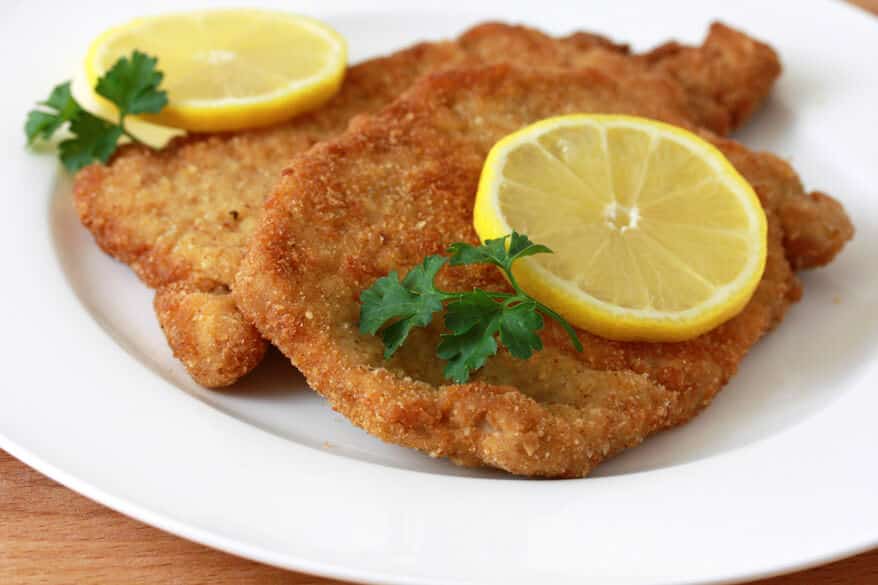
What to Serve with Schnitzel
In Germany, Schnitzel is commonly served with any of the following:
- Pommes (French fries); see my Oven Baked French Fries or Baked Potato Wedges.
- Spaetzle and gravy
- German Potato Salad
- Creamy German Cucumber Salad
- Krautsalat
- A leafy green salad
Additional serving options include mashed or roasted potatoes, Sauerkraut, Rotkohl, and roasted or steamed veggies. And if you want to pair it with some non-German sides you can serve it with classics like Creamy Coleslaw, Macaroni Salad, Classic Potato Salad, Baked Potato Wedges, Baked Beans, or Broccoli Salad.
Enjoy!
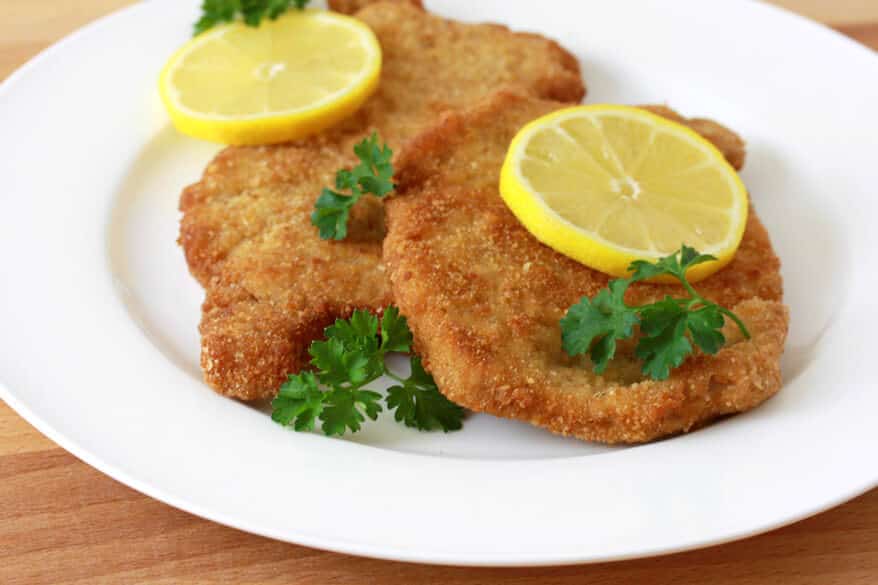
For more authentic German recipes be sure to try my:
- Sauerbraten
- Rouladen
- Schweinshaxe
- Königsberger Klopse
- Currywurst
- Käsespätzle
- Kartoffelpuffer
- Senfbraten
- Jägerschnitzel
- Maultaschen
- German Potato Soup
- Frikadellen
- German Sauerkraut Soup
Save This Recipe
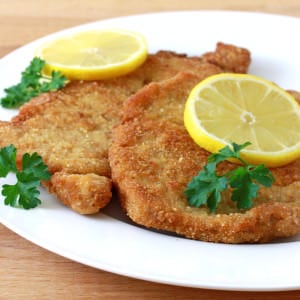
Traditional German Schnitzel (Schweineschnitzel)
Ingredients
- 4 boneless pork steaks or chops, (to make Austrian Wienerschnitzel use thin veal cutlets)
- salt and freshly ground black pepper
- 1/2 cup all-purpose flour combined with 1 teaspoon salt
- 2 large eggs, lightly beaten
- 3/4 cup plain breadcrumbs
- Oil for frying (use a neutral-tasting oil with a high smoke point)
Instructions
- Place the pork chops between two sheets of plastic wrap and pound them until just 1/4 inch thick with the flat side of a meat tenderizer. Lightly season both sides with salt and freshly ground black pepper.
- Place the flour mixture, egg, and breadcrumbs in 3 separate shallow bowls. Dip the chops in the flour, the egg, and the breadcrumbs, coating both sides and all edges at each stage. Be careful not to press the breadcrumbs into the meat. Gently shake off the excess crumbs. Don't let the schnitzel sit in the coating or they will not be as crispy once fried – fry immediately.Make sure the cooking oil is hot enough at this point (about 330 degrees F) as you don't want the Schnitzel to sit around in the coating before frying. Use enough oil so that the Schnitzels "swim" in it.Fry the Schnitzel for about 2-3 minutes on both sides until a deep golden brown. Transfer briefly to a plate lined with paper towels.
- Serve immediately with slices of fresh lemon and parsley sprigs. Serve with French fries, Spätzle or German potato salad, and a fresh leafy green salad.
Video
Nutrition
Originally published on The Daring Gourmet March 12, 2014




















I searched the internet for the right recipe and when I saw this recipe my hunt was over. Delicious!
Fantastic, Diane, I’m so glad your searching paid off – thank you!
I was in Germany for 6 years, I love the schnitzel and also cordon bleu, I would love the cordon bleu recipe
Looks yummy! One of my favorite Authentic German Schnitzel, nice to see your recipe, easy to follow, will cook this for family this weekend. Thank you!
Authentic and crispy recipe!
first time trying schnitzel but i highly recommend using a conventional oven. All i had was a microwave and tried a little recipe on my own. It was a little chewy but flavor was well. Two thumbs up!
I actually never use flour when making schnitzel. That’s how is wa taught. Other cutlets yes, but I always make my thin schnitzel without the flour and it comes out perfectly! Maybe my grandmother taught me this? Regardless I appreciate the one less step :)
What oil did you use to fry your Schnitzel?
First generation Australian and frankly love to know I’m making Schnitzel as authentic as possible. Importantly though as yummy as possibly good pointers and I’ve tried this method out a few times now. Ta.
Thanks so much, Lou, and friendly greetings to Australia!
Superb recipe and so Delightfully easy.
It came out delicious
Thank you, Vikram, I’m so glad you enjoyed it!